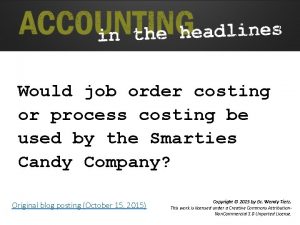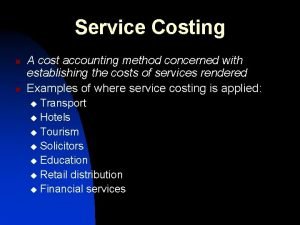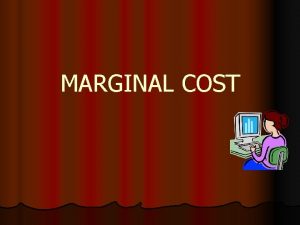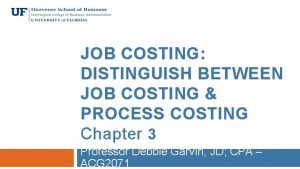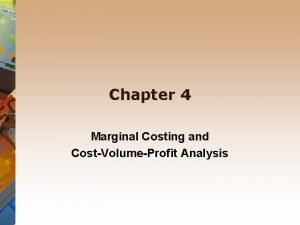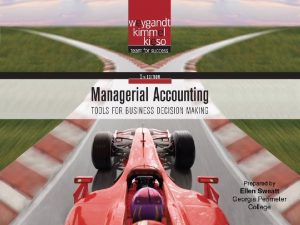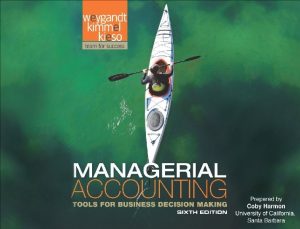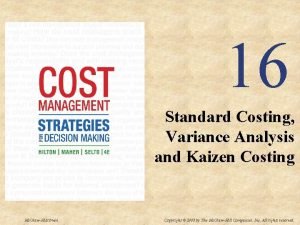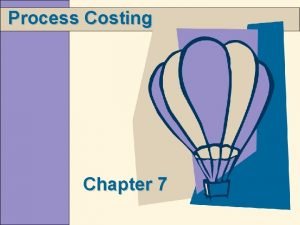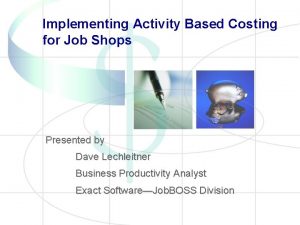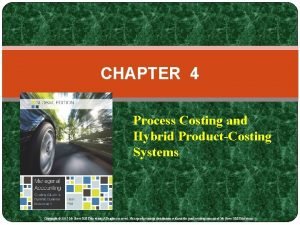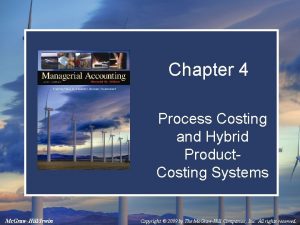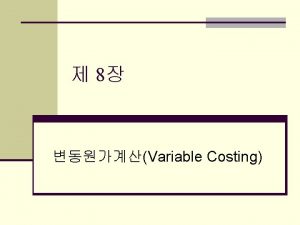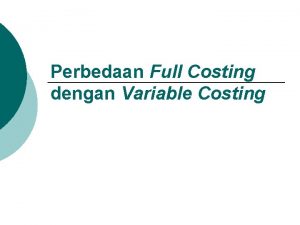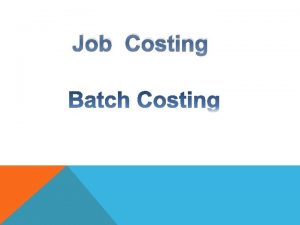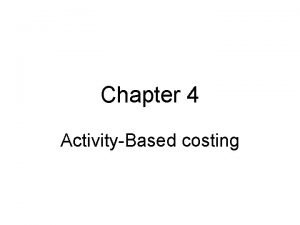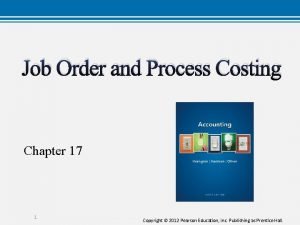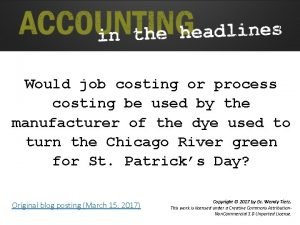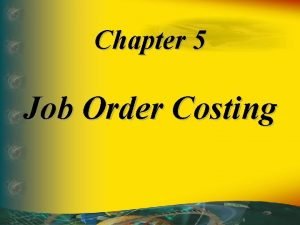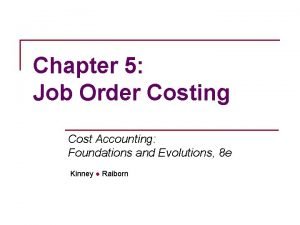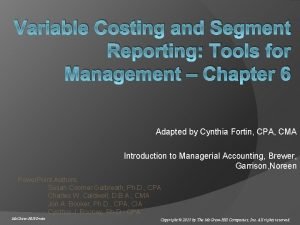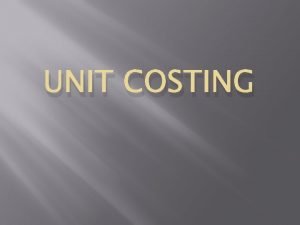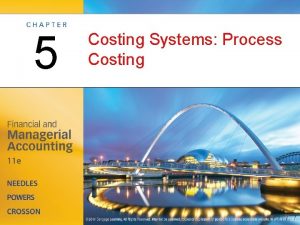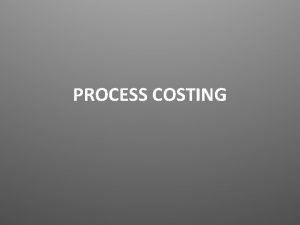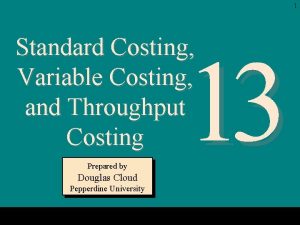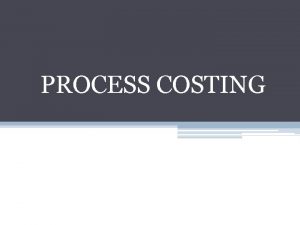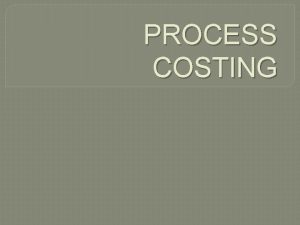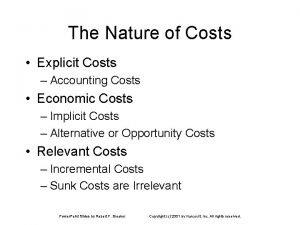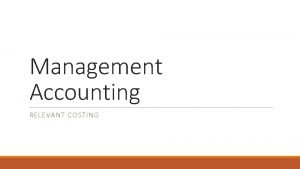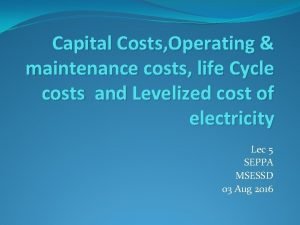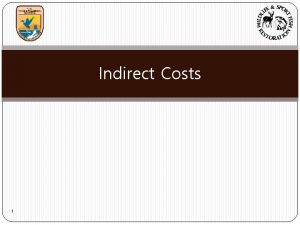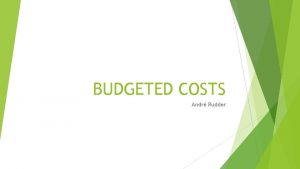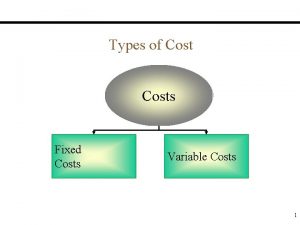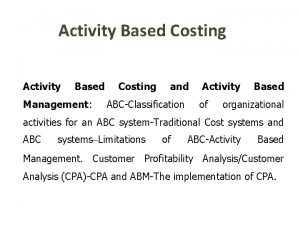Management Accounting Costing Management Accounting Management Accounting Costs




























- Slides: 28

Management Accounting (Costing)

Management Accounting • Management Accounting - • Costs - Industrial revolution Production cost per unit Management activities Direct and indirect Trading services Tariff calculation • Costing methodology - • Prerequisites - ABC Internal billing Departmental charges Policy Base cost and Formulas 2

Financial and Management Accounting: Recording Estimating Organising Summarising Fin. Accounting: Man. Accounting: Reporting - external Financial consequences Objective, verifiable Precise Summarised for reports GRAP complaint Mandatory Reporting - internal Financial decisions Relevance for purpose Timeline is required Segment reporting Not GRAP requirement Non-mandatory 3

Primary Transaction – Bulk merge from payroll March 2016 Dr Description Employee related cost: March 2016 Project Function Municipal Running Asset Management Cost Item Basic Salary and Wages Fund Property Rates Costing Default Region Administrative or Head Office Employee related cost: March 2016 Municipal Running Asset Management Cost Group Life Insurance Property Rates Default Administrative or Head Office Employee related cost: March 2016 Municipal Running Asset Management Cost Medical Property Rates Default Administrative or Head Office Employee related cost: March 2016 Municipal Running Asset Management Cost Pension Property Rates Default Administrative or Head Office Employee related cost: March 2016 Municipal Running Asset Management Cost Unemployment Insurance Property Rates Default Administrative or Head Office Payment of Employee related cost: March 2016 Municipal Running Cost Bank Account: Withdrawals Property Rates Amount 3 000, 00 75, 00 210, 00 270, 00 30, 00 Cr Asset Management Default Administrative or Head Office -3 585, 00 Bulk merge file from payroll system for the month of March 2016. (We pretend that all monies is immediately paid and do not use the clearing accounts for this example - 4

Secondary Costing Transaction – Departmental charges at a % Dr Description Project Function Item Fund Costing Region Relocation of costs Default Community Halls and Charges: Departmental No regional Identifier Facilities Charges: Asset management Cr Relocation of costs Default Fire Fighting and Protection Default Charges: Departmental No regional Identifier Charges: Asset management Relocation of costs Default Waste Management Default Charges: Departmental No regional Identifier Charges: Asset management Relocation of costs Default Waste Water Management Default Charges: Departmental Charges: Asset management Relocation of costs Default Water Default Charges: Departmental No regional Identifier Charges: Asset management Relocation of costs Default Electricity Default Charges: Departmental No regional Identifier Charges: Asset management Relocation of Costs Default Departmental Charges at a % allocation Asset Management Default Own Allocation Amount formula 28, 68 1% 573, 60 20% 516, 24 18% 860, 40 30% No regional Identifier No regional Recoveries : Identifier Departmental Charges: Asset management -2 868, 00 - 5

Costing Segment: Activity Based Costing

Types of Costs • Direct Costs- can be traced directly to one output e. g. number of water kilolitres per household. • Indirect Costs- in benefit a wide number of outputs e. g. maintenance costs incurred for a pool vehicle. • Since indirect costs can not be traced and allocated directly to a single output, different methods can be used. One of the methods would be Activity Based Costing (ABC). • The method requires an identification of activity pool and a cost driver for each activity. 7

Allocation of indirect costs Activity cost pools INDIRECT/ OVERHEAD COSTS Activity cost drivers Vehicle maintenance costs Cost per kilometre Water consumption Cost per kilolitre Office lease expense Cost per square metre 8

Activity Based Costing • Tracing resource consumption and allocating costs to an activity based on the number of final outputs. • Example: space used for office rental, kilometres used on a pool vehicle, number of attendees for training and number of events held. Cost of Vehicle Maintenance per annum Usage Kilometre per Department (km) Activity cost pools (R) Finance 5, 000 Service 5, 360 Corporate Services 15, 000 Depreciation 40, 000 Technical Services 5, 000 Insurance 16, 800 Community Services 5, 000 Licencing 300 Planning and Development 5, 000 Fuel 33, 600 Municipal Manager 5, 000 Breakdown 8, 000 Tyres 4, 000 40, 000 108, 060 Cost Driver: Cost per kilometer (R 108060/40000 km)- Charge Out Rate R 2. 70 9

Costing Segment: Internal Billing

Internal Billing Metered cost The recovery of services and products that are consumed internally by other departments. Example: Electricity consumed by the Water department. If invoiced, then the billing is considered to be a primary transaction – costing segment is not used The costing segment is used to recover these costs in the absence of an invoice and will result in a secondary cost which is a below the line cost. Below the line costs are not included in the AFS but are elements of management accounts

Internal Billing Housing Waste Management This expense need to be billed Total to electricity the various departments used perthat used the meter electricity readings Energy 11950 Watts Waste Water Management

Internal Billing Housing 3500 Watts Waste Management 5000 Watts Bi ll As peron Based meters actualin each usage department Energy 11950 Watts Waste Water Management 2000 Watts Water Management 1450 Watts

Costing Segment: Departmental Charges

Departmental Charges The distribution of primary costs via a pro-rata approach. All distributed costs results in secondary , below the line costs Examples include the distribution of overheads like office rental, ICT costs and security costs. The cost pool can be apportioned by applying a percentage formula. Cost Drivers - Number of individuals per department - Floor space per department - Any other appropriate activity driver

Departmental Allocation Waste Management 60 employees Housing 15 employees Waste Water Management Through an 40+20+15+30 15 employees How should Thus 60/150 = 15/150 = 10% 30/150 20% appropriate +35 = 150 Audit Fees we allocate 40% activity driver employees in this 10% oftotal R 450 of 000 20% eg. Number expense? 40% R 450 000 = of R 45 000 R 90 employees per = 180 000 department 30 employees Finance and Administration R 450 000 Water Management 30 employees

m. SCOA Practical Examples

Practical examples Gariep municipality’s electricity department shares the building with the water distribution department. The rent is paid and allocated to the financial department. The water distribution department also shared the pool vehicle that was allocated to the electricity department but kept a log book. 1. The municipality paid rent of R 16000. 00 excl vat. It was established that the Water Management department only occupies 25% of the building and the pro- rata approach will be used to apportion the rent using the costing segment. 2. As per the log book, a total of 30 000 km was travelled by the pool car. It was further established that the Water Management department used 10 000 km. Use the costing system to allocate the vehicle cost to the water section taking into consideration the following costs: Ø Depreciation – R 40 000 Ø Maintenance- R 15 000 Ø Fuel- R 9000 3. The electricity department also issues a bill to the finance department for electricity services to the value of R 16 000. Use the costing system to charge this service to the finance department. 18

Practical examples Solution 1 The rent ( R 16000) is split by percentage: Water Distribution: 25% - R 4 000 Electricity: 75% - R 12 000 Solution 2: Cost Pool = 40 000 + 9 000 + 5 000 = 54 000 Cost driver = cost/total mileage = 54 000 / 30 000 KM = R 1. 80 per KM Cost to Water distribution: = 10 000 x R 1. 80 = R 18 000. 00 Solution 3 Electricity Cost billed to Water distribution= R 16 000 19

Practical examples Solution 1 SEGMENT FINANCE ELECTRICITY WATER DIST PROJECT DEFAULT FUNCTION FINANCE & ADMIN: CORE FUNCTION: FINANCE ENERGY SOURCES: CORE: ELECTRICITY WATER MANAG. : CORE: WATER DISTRIBUTION FUND NON FUNDING ITEM DEFAULT COSTING RECOVERIES: DEPARTMENTAL: OFFICE RENTALS CHARGES: DEPARTMENTAL: OFFICE RENTALS REGIONAL DEFAULT MSC FINANCE DEPT. TECH. SERVICES AMOUNT - R 16 000. 00 R 12 000. 00 R 4 000. 00 20

Practical examples Solution 2 SEGMENT ELECTRICITY WATER DIST PROJECT DEFAULT FUNCTION ENERGY SOURCES: CORE: ELECTRICITY WATER MANAG. : CORE: WATER DISTRIBUTION FUND NON FUNDING ITEM DEFAULT COSTING RECOVERIES: ABC: VEHICLES: OPERATING CHARGES: ABC: VEHICLES: OPERATING REGIONAL DEFAULT MSC DEFAULT AMOUNT - R 18 000. 00 21

Practical examples Solution 3 SEGMENT ELECTRICITY WATER DIST PROJECT DEFAULT FUNCTION ENERGY SOURCES: CORE: ELECTRICITY WATER MANAG. : CORE: WATER DISTRIBUTION FUND NON FUNDING ITEM DEFAULT COSTING RECOVERIES: INTERNAL BILLIN ELECT. CONSUMPTION CHARGES: INTERNAL BILLIN ELECT. CONSUMPTION REGIONAL DEFAULT MSC DEFAULT AMOUNT - R 16 000. 00 22

Costing Segment: Tariff Setting

Need for Cost Accounting (Cost Reflective Tariffs) q By only inflation adjusting tariffs there is no real growth in income q Increased real growth in income is essential to: § Improve and sustain service delivery levels § Fund repairs and maintenance and renewal of infrastructure. q Assists to realise the full revenue potential of the municipality q Ensures that tariff services are adequately funded over the long term, resulting in an efficient, sustainable and reliable service q Full cost recovery is the process of gathering and reporting information about the true cost (direct plus indirect costs) of providing a service by tracking and accumulating the total cost of the process to provide the service q Planning to recover the full cost of services (cost-reflective tariffs) is a structured, transparent methodology of setting tariffs that is designed to take both financial sustainability and affordability into consideration q Imperative that the full cost of rendering a particular service is known so that tariff decisions are taken with full knowledge of the cross-subsidy that will be required and provided from other revenue sources q Improved budgeting - Understanding demand how costs are reflective of demand for a services allows municipalities to budget better q Transparency - Citizens need to understand the cost drivers and how tariffs are calculated q Municipalities that apply full cost recovery are in general very efficient and provide a high level of service, contributing to customer satisfaction and thereby encouraging payment for services, resulting in investment for replacement and expansion of services. 24

Benefits of Implementing Cost Accounting – (Cost Reflective Tariffs) q Provides a better understanding and consistent approach across municipalities with regard to the principles and techniques of cost allocation, and ability to benchmark costs against municipalities of a similar size q Provides accurate and complete information on the real cost of managing a tariff service: § Increase the accuracy of cost information by identifying secondary costs and assigning it to specific municipal services § Assist with resource allocation for a particular service § Provide a basis for tariff setting to implement full cost recovery on tariff services q Ensures that those who are using the services are paying the full cost of the service q Provides transparency with regard to cross-subsidisation between consumer groups q Managers will have a better understanding of their costs and will be able to predict future costs more precisely q Promotes allocation of internal resources, ensuring that available resources are utilised optimally, and duplication of services can be identified q Identification of and making informed decisions about potential inefficiencies and cost savings, as well as the types and levels of services provided q Ensures correct pricing of services (and will result in consumers not abusing scarce resources) 25

Risks of Not Implementing Full Cost Recovery q Inability to finance network expansions, or properly maintain existing infrastructure resulting in low service levels, which in turn will have a negative effect on the willingness of customers to pay q Low levels of cost recovery from the user will result in insufficient income for the effective and efficient operation and management of the service q Inability to further invest in the service, which can result in a possible loss of scarce resources such as water if the infrastructure is not maintained properly q Potential for cross-subsidisation from property rates or other services q A widening gap between full cost and current expenditure will result in huge tariff increases when rectified q No transparency around tariff determination q An increase in emergency repairs against scheduled or preventative maintenance q An increased risk of more service outages, as preventative maintenance is not being done, with the accompanying inconvenience for customers and loss of revenue for the municipality q A steady degradation of system infrastructure, resulting in a reduction of service level standards. q Reduced ability to attract new business q Can result in higher insurance costs, a lower credit rating and higher lending costs 26

Illustration of tariff calculation 27

28
 Job order costing vs process costing
Job order costing vs process costing Companies that use job order costing
Companies that use job order costing Service costing examples
Service costing examples Marginal costing meaning
Marginal costing meaning Job costing definition
Job costing definition Differentiate between job costing and process costing
Differentiate between job costing and process costing Contract costing definition
Contract costing definition Variable costing vs absorption costing
Variable costing vs absorption costing Assumptions for cvp analysis
Assumptions for cvp analysis Abc costing vs traditional costing
Abc costing vs traditional costing Job costing system vs process costing system
Job costing system vs process costing system Objectives of activity based costing
Objectives of activity based costing Kaizen emfasis
Kaizen emfasis Process costing and hybrid product-costing systems
Process costing and hybrid product-costing systems Wip control account
Wip control account Job shop pricing
Job shop pricing Hybrid costing system example
Hybrid costing system example Operation costing is a hybrid of
Operation costing is a hybrid of Mixed cost
Mixed cost Perbedaan full costing dan variable costing
Perbedaan full costing dan variable costing Objectives of job costing
Objectives of job costing Target costing and activity based costing
Target costing and activity based costing Standard costing meaning
Standard costing meaning Example of cost sheet
Example of cost sheet Contoh full costing dan variable costing
Contoh full costing dan variable costing Job costing with process costing
Job costing with process costing Job order cost
Job order cost Site:slidetodoc.com
Site:slidetodoc.com Variable costing and segment reporting tools for management
Variable costing and segment reporting tools for management

